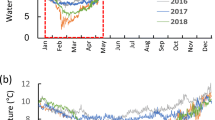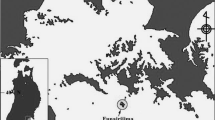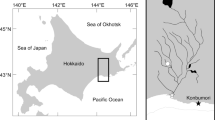Abstract
The kelp Saccharina japonica is a dominant seaweed along the Sanriku coast where fisheries for sea urchin and abalone are among the most prosperous in Japan. We investigated the phenology of the kelp at depths of 6, 9 and 12 m from March 2015 to March 2016. The sea urchin Mesocentrotus nudus, a dominant herbivore off the coast, was also monitored with respect to its gonads for fishery use. Juvenile kelp appeared in March and rapidly elongated until May. Weight of the kelp significantly increased from April to July. Sori formation commenced from September and ceased in December. Density and biomass of the kelp were higher in the shallower sites than in the deeper one throughout the year. The highest biomasses recorded between July and October were 3773, 1939 and 501 g dry weight m−2 at depths of 6, 9 and 12 m, respectively. No regrowth of kelp blades was observed, indicating that S. japonica in this region has an annual life cycle. The gonad index of the sea urchin in the 12-m site was lower than that in the 6- and 9-m sites, indicating the close relation of the gonad index with the biomass of the kelp.








Similar content being viewed by others
References
Musashi T, Sakasita K, Nakai K, Inokuchi N, Saido T, Uchida T (1993) Studies on lifestyle and production of “konbu”. Annual report of the Iwate Prefectural Institute of Fisheries Stock Enhancement, pp 75–79 (in Japanese)
Nishida Y (1999) Relation between hydrographic conditions and harvest of konbu kelp. In: Taniguchi K (ed) The ecological mechanism of “Isoyake” and marine afforestation. Kouseisya Kouseikaku, Tokyo, pp 50–61 (in Japanese)
Kirihara S, Nakamura T, Notoya M (2003) Effect of water temperature on the growth of Laminaria japonica (Laminariales, Phaeophyceae) at the coast of Shiriyazaki, Shimokita Peninsula, Japan. Suisanzoshoku 51:273–280 (in Japanese with English abstract)
Fujiwara Y (2008) Sanriku coast/Iwate Prefecture. In: Fujita D et al (eds) Recovery from urchin barrens—ecology, fishery and utilization of sea urchin. Seizando Shoten, Tokyo, pp 39–43 (in Japanese)
Nakawaki T, Agatsuma Y, Taniguchi K (2001) Annual life cycle and productivity of the Laminaria japonica population in Onagawa Bay, northeastern Honshu, Japan. Suisanzoshoku 49:439–444 (in Japanese with English abstract)
Funano T (1980) Ecological and maricultural studies on Laminaria japonica growing on the shores of Date City, Hokkaido. I. Ecology of L. japonica. Sci Rep Hokkaido Fish Exp Stn 22:17–77 (in Japanese with English abstract)
Dayton PK, Tegner MJ, Parnell PE, Edwards PB (1992) Temporal and spatial patterns of disturbance and recovery in a kelp forest community. Ecol Monogr 62:421–445
Choat JH, Schiel DR (1982) Patterns of distribution and abundance of large brown algae and invertebrate herbivores in subtidal regions of northern New Zealand. J Exp Mar Biol Ecol 60:129–162
Vadas RL (1977) Preferential feeding: an optimization strategy in sea urchins. Ecol Monogr 47:337–371
Agatsuma Y, Motoya S, Sugawara Y (1988) Reproductive cycle and food ingestion of the sea urchin, Strongylocentrotus nudus (A. Agassiz), in southern Hokkaido. I. Seasonal changes of the gonad. Sci Rep Hokkaido Fish Exp Stn 30:33–41 (in Japanese with English abstract)
Yatsuya K, Nakahara H (2004) Density, growth and reproduction of the sea urchin Anthocidaris crassispina (A. Agassiz) in two different adjacent habitats, the Sargassum area and Corallina area. Fish Sci 70:233–240
Agatsuma Y (1997) Ecological studies on the population dynamics of the sea urchin Strongylocentrotus nudus. Sci Rep Hokkaido Fish Exp Stn 51:1–66 (in Japanese with English abstract)
Nakabayashi N, Miura N, Agatsuma Y, Taniguchi K (2006) Growth and gonad production of the sea urchin Strongylocentrotus nudus in relation to marine algal communities along the Japan Sea coast of Akita Prefecture, northwestern Japan. Aquac Sci 54:365–374 (in Japanese with English abstract)
R Core Team (2017) R: a language and environment for statistical computing. R Foundation for Statistical Computing, Vienna. https://www.R-project.org/
Kawashima S (2004) Konbu. In: Ohno M (ed) Biology and technology of economic seaweeds. Uchida Rokakuho, Tokyo, pp 59–85 (in Japanese)
Kain JM (1977) The biology of Laminaria hyperborea X. The effect of depth on some populations. J Mar Biol Assoc UK 57:587–607
Sakanishi Y, Ito H, Iizumi H (2004) Photosynthetic light-response curves of cold water species of Laminariales at the eastern Pacific coast of Hokkaido, Japan. Jpn J Phycol 52(suppl.):33–39 (in Japanese with English abstract)
Odagiri A, Asuke M, Sato K (1984) Gonadal maturation of the sea urchin, Strongylocentrotus nudus, inhabiting the deep water off shore of Okoppe, Aomori Prefecture. Sci Rep Aquac Cent Aomori Prefect 3:1–7 (in Japanese with English abstract)
Tsuji S, Yoshiya M, Tanaka M, Kuwahara A, Uchino K (1989) Seasonal changes in distributions and ripeness of gonad of a sea urchin Strongylocentrotus nudus in the western part of Wakasa bay. Bull Kyoto Inst Fish Ocean Sci 12:15–21 (in Japanese with English abstract)
Agatsuma Y (1999) Gonadal growth of the sea urchin, Strongylocentrotus nudus, from trophically poor coralline flats and fed excess kelp, Laminaria religiosa. Suisanzoshoku 47:325–330 (in Japanese with English abstract)
Acknowledgements
We express our sincere thanks to Mr. Yuichi Kohsaka and Mr. Naoki Kimura of the Omoe Fisheries Cooperative Association who helped us carry out the field investigation.
Author information
Authors and Affiliations
Corresponding author
Rights and permissions
About this article
Cite this article
Yatsuya, K., Matsumoto, Y., Sasaki, K. et al. Phenology of the kelp Saccharina japonica and its effect on the gonad index of the sea urchin Mesocentrotus nudus across a depth gradient off the Sanriku coast, northeastern Japan. Fish Sci 83, 939–946 (2017). https://doi.org/10.1007/s12562-017-1119-8
Received:
Accepted:
Published:
Issue Date:
DOI: https://doi.org/10.1007/s12562-017-1119-8




